Clinical Findings in Psoriasis
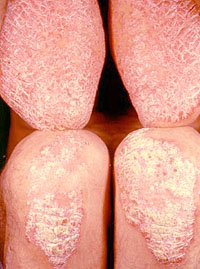 Although no part of the skin is separated, some areas are especially chosen. Characteristic localizations are knees, elbows, lumbosacral area, scalp and genital area. Although no part of the skin is separated, some areas are especially chosen. Characteristic localizations are knees, elbows, lumbosacral area, scalp and genital area.
When the psoriatic lesions heal post-inflammatory hyperpigmentation, hypopigmentation or depigmentation may occur. Often a hypopigmente zone is observed, known as Woronoff ring.
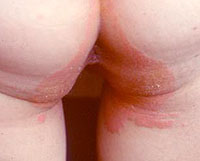 Intertriginous psoriasis: Isomorphic irritation, which is the result of the heat and perspiration helps to form psoriasis in intertriginous areas. In these warm and moist areas, the scales are usually absent. The erythematous patches are sharply bordered and slightly infiltrated. When seen in the anal region it can be confused with anal eczema. The sharp borders of the fissurated patches are diagnostic for psoriasis. Intertriginous psoriasis must be differentiated from eczema, candidiasis, and macerated tinea pedis. Intertriginous psoriasis: Isomorphic irritation, which is the result of the heat and perspiration helps to form psoriasis in intertriginous areas. In these warm and moist areas, the scales are usually absent. The erythematous patches are sharply bordered and slightly infiltrated. When seen in the anal region it can be confused with anal eczema. The sharp borders of the fissurated patches are diagnostic for psoriasis. Intertriginous psoriasis must be differentiated from eczema, candidiasis, and macerated tinea pedis.
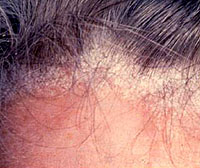 Psoriasis of the scalp: Psoriasis involves the scalp very often. Sharply bordered patches are seen with overlying severe scales. Sometimes it is difficult to distinguish from seborrheic dermatitis. This situation may occur by the Köbner phenomenon (Sebopsoriasis). Histopathologically the presence of Munroe abcess is diagnostic. Usually hair loss is not seen. But in case of generalized pustular psoriasis, diffuse hair loss may be seen due to toxic origin. Psoriasis of the scalp: Psoriasis involves the scalp very often. Sharply bordered patches are seen with overlying severe scales. Sometimes it is difficult to distinguish from seborrheic dermatitis. This situation may occur by the Köbner phenomenon (Sebopsoriasis). Histopathologically the presence of Munroe abcess is diagnostic. Usually hair loss is not seen. But in case of generalized pustular psoriasis, diffuse hair loss may be seen due to toxic origin.
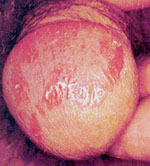 Penile psoriasis: The penis may be the initial site of psoriasis in a fair percentage of young patients. In rare cases it may be the only site. Penile psoriasis tends to be less scaly and present as a red infiltrated plaque with a varnished surface. It must be distinguished from lichen planus, Zoon balanitis, Bowen disease, Bowenoid papulosis, and candidiasis. Penile psoriasis: The penis may be the initial site of psoriasis in a fair percentage of young patients. In rare cases it may be the only site. Penile psoriasis tends to be less scaly and present as a red infiltrated plaque with a varnished surface. It must be distinguished from lichen planus, Zoon balanitis, Bowen disease, Bowenoid papulosis, and candidiasis.
Nail changes: Nail involvement is common in psoriasis. The most typical sign is pitting. The tiny pits are produced by the desquamation of the focal poorly compacted areas of parakeratosis in the growing nail. Another common sign is oil spot. Furthermore onycholysis, subungual hyperkeratosis, abnormalities of the nail bed and splinter hemorrhages can be seen in psoriasis. The nail changes of psoriasis mostly imitate the fungal infections of the nails.
|
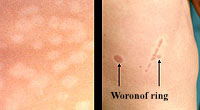
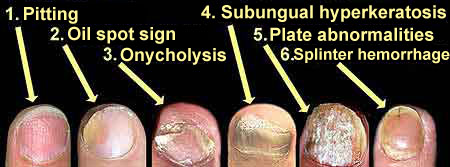
 Although no part of the skin is separated, some areas are especially chosen. Characteristic localizations are knees, elbows, lumbosacral area, scalp and genital area.
Although no part of the skin is separated, some areas are especially chosen. Characteristic localizations are knees, elbows, lumbosacral area, scalp and genital area. Intertriginous psoriasis: Isomorphic irritation, which is the result of the heat and perspiration helps to form psoriasis in intertriginous areas. In these warm and moist areas, the scales are usually absent. The erythematous patches are sharply bordered and slightly infiltrated. When seen in the anal region it can be confused with anal eczema. The sharp borders of the fissurated patches are diagnostic for psoriasis. Intertriginous psoriasis must be differentiated from eczema, candidiasis, and macerated tinea pedis.
Intertriginous psoriasis: Isomorphic irritation, which is the result of the heat and perspiration helps to form psoriasis in intertriginous areas. In these warm and moist areas, the scales are usually absent. The erythematous patches are sharply bordered and slightly infiltrated. When seen in the anal region it can be confused with anal eczema. The sharp borders of the fissurated patches are diagnostic for psoriasis. Intertriginous psoriasis must be differentiated from eczema, candidiasis, and macerated tinea pedis. Psoriasis of the scalp: Psoriasis involves the scalp very often. Sharply bordered patches are seen with overlying severe scales. Sometimes it is difficult to distinguish from seborrheic dermatitis. This situation may occur by the Köbner phenomenon (Sebopsoriasis). Histopathologically the presence of Munroe abcess is diagnostic. Usually hair loss is not seen. But in case of generalized pustular psoriasis, diffuse hair loss may be seen due to toxic origin.
Psoriasis of the scalp: Psoriasis involves the scalp very often. Sharply bordered patches are seen with overlying severe scales. Sometimes it is difficult to distinguish from seborrheic dermatitis. This situation may occur by the Köbner phenomenon (Sebopsoriasis). Histopathologically the presence of Munroe abcess is diagnostic. Usually hair loss is not seen. But in case of generalized pustular psoriasis, diffuse hair loss may be seen due to toxic origin. Penile psoriasis: The penis may be the initial site of psoriasis in a fair percentage of young patients. In rare cases it may be the only site. Penile psoriasis tends to be less scaly and present as a red infiltrated plaque with a varnished surface. It must be distinguished from lichen planus, Zoon balanitis, Bowen disease, Bowenoid papulosis, and candidiasis.
Penile psoriasis: The penis may be the initial site of psoriasis in a fair percentage of young patients. In rare cases it may be the only site. Penile psoriasis tends to be less scaly and present as a red infiltrated plaque with a varnished surface. It must be distinguished from lichen planus, Zoon balanitis, Bowen disease, Bowenoid papulosis, and candidiasis.